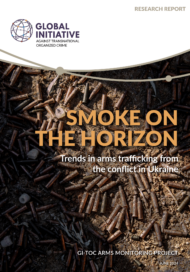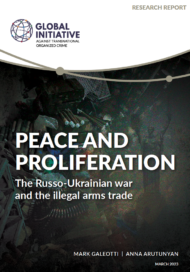Posted on 24 Jun 2024
Advocates of gun control often interpret ‘control’ as a limiting exercise: reduce the number of firearms in civilian hands, reduce the levels of violence in society. This has been one strand of the gun control debate in the United States, where guns are sold legally in many states, and where a number of mass shootings have been attributed to the country’s lax gun laws. In Ukraine, however, the public debate around gun control is almost completely reversed.
As ‘Smoke on the horizon: Trends in arms trafficking from the conflict in Ukraine’, the Global Initiative Against Transnational Organized Crime (GI-TOC)’s latest report on arms trafficking from the conflict, highlights, the country has seen a massive profusion of weapons over the past decade, particularly since the Russian invasion in February 2022. One official estimate puts the number of trophy weapons – weapons collected from the battlefield – at up to 5 million. Notably, these weapons are mostly Russian or Soviet-type, and are often found in places where the Russian army made rapid and disorganized retreats in 2022. In addition, several million Soviet, Western-made and Ukrainian weapons were already circulating in the country before the full-scale invasion, not all of which are necessarily registered.
Limiting civilian access to such weapons is impossible: the guns are already there, in civilian hands. Rather, the challenge of ‘gun control’ is how best to deal with this reality, and how to reduce the risks and potential harm posed by the large number of guns in the country.
Tackling profusion at source
The GI-TOC’s illicit arms monitoring exercise has shown that there has been no organized or large-scale flow of arms from Ukraine to the rest of Europe since 2022, despite widespread concerns and false claims to the contrary.
The issue of gun control is taken very seriously by Ukrainian authorities – given the vital interest they have in international military support and the political risks of portraying an image of laxity regarding weapons – and has been well supported by international partners. Crucially, although many trophy weapons have found their way into civilian hands, organized crime in Ukraine has not structured the illegal arms market: when arms transactions do take place, they are generally made or attempted by civilians and military personnel, and involve individual trophy weapons. With Russian aggression a daily reality and the Ukrainian state unable to guarantee their security, most civilians see weapons as a means of self-protection, and not as an opportunity for profit.
This situation presents a conundrum for policymakers as they adapt to the changing shape of the conflict. When the country improvised its defence in February 2022, the authorities issued thousands of weapons to civilians and rushed through legislation allowing civilians to use them to defend Ukraine during the period of martial law. Now, more and more civilians support the idea of legal gun ownership: a survey in mid-2022 found 58 per cent of citizens were in favour, as opposed to the 70 per cent who were against in 2018–2021.
At present, however, there is a mismatch between popular sentiment and the current draft legislation. A second draft allowing civilians to use weapons is being prepared, with over 700 proposed amendments, including more restrictive criteria for owning weapons, especially handguns. Under this law, if adopted, civilians would be allowed to keep weapons for self-defence, but would have to register them with the police. Crucially, the period of authorization is limited to the conflict: civilians must return such weapons to the police within 90 days of the end of martial law, with some possibilities for legalizing ownership.
The sheer number of weapons in the country, combined with the continuing reality of Russian aggression, means that many are pushing for a more fundamental rethink of Ukraine’s gun laws. According to these arguments, civilians should have the right to acquire and bear arms. Currently, peacetime norms for civilian gun ownership are regulated not by law, but by Directive 622 (1998), issued by the Ministry of Internal Affairs, which has been supplemented by wartime decrees. According to the directive, citizens can legally obtain permits for a wide range of hunting and sporting rifles, but the purchase of handguns is prohibited for all except law enforcement personnel.
Although a highly charged issue, legalizing many of the weapons currently in civilian hands may be the only pragmatic way to bring some degree of transparency and control. It is also a realistic method of preventing gun proliferation in the country and the region, if legalization is accompanied by a digital registry and tracking system. Government-sponsored buy-backs will be expensive and limited in scope, while seizures can only remove a tiny fraction of the total number of weapons.
At present, although there is currently a requirement for all weapons in civilian hands to be registered in Ukraine’s Unified Arms Registry (established in June 2023), many may be choosing not to register, as this would force them to return their means of protection at the end of the war. This massive stockpile of weapons and ammunition will remain invisible to the authorities and law enforcement agencies. On the other hand, the option of legalizing the weapons may make Ukrainians feel more comfortable registering them and take a significant share of these weapons off the grey and black markets. However, some kinds of trophy weapons and explosives – such as grenades, rocket launchers and mines – should not benefit from such a pathway, and seizures, amnesties and other forms of interdiction will be necessary to remove them from the market.
Without this kind of release valve, the risks of arms trafficking may multiply. If civilians are unable to legalize trophy weapons, they may choose to either hide or sell them instead, while the vast number of untracked weapons may provide a reservoir for organized crime and traffickers. Weapons-related crime may increase, especially given the high number of trained users returning from the front lines.
This would not only be a problem for Ukraine. The supply of small arms from the Western Balkans to Western Europe has not ceased since the end of the Balkan wars nearly 30 years ago. A similar scenario could unfold in a potential post-conflict or prolonged ceasefire situation in Ukraine. At present, as ‘Smoke on the horizon’ shows, it is still significantly cheaper to procure an illegal weapon in the Western Balkans than in Ukraine. However, once a tipping point is reached in terms of pricing and availability, the oversupply of weapons could open a Pandora’s box for Europe.
While not a clear-cut issue, the current situation in Ukraine requires fresh and context-specific thinking on the issue of gun control. And time is of the essence. The GI-TOC’s new report highlights that arms trafficking in Ukraine is currently organic and small-scale, with little involvement from organized crime. As such, there is a critical window of opportunity now to adopt and implement an effective legal framework that can address illegal arms in Ukraine before they become a major organized crime risk.



